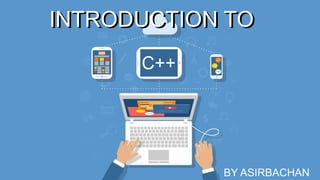
INTRODUCTION TO C
- 1. INTRODUCTION TO C++ INTRODUCTION TO BY ASIRBACHAN
- 2. C++ Character Set Letters A-Z, a-z Digits 0-9 Special Characters Space + - * / ^ () [] {} = != <> ‘ “ $ , ; : % ! & ? _ # <= >= @ Formatting characters backspace, horizontal tab, vertical tab, form feed, and carriage return Character set is a set of valid characters that a language can recognize.
- 3. Tokens A token is a group of characters that logically belong together. The programmer can write a program by using tokens. C++ uses the following types of tokens. Keywords, Identifiers, Literals, Punctuators, Operators. SUBJECT VERB OBJECT #include <iostream> void main() cout<< “hello world” ; { } Like a sentence has parts of speeches used in it. In the same way C++ statements are made of tokens.
- 4. Keywords These are some reserved words in C++ which have predefined meaning to compiler called keywords. BOTTLEBAG Everything in this world has a specific name. You cannot call it by any other name. This is what exists in C++ also. There are words in C++ with predefined meanings and cannot be represented by any other word.
- 5. Identifiers Symbolic names can be used in C++ for various data items used by a programmer in his program. A symbolic name is generally known as an identifier. The identifier is a sequence of characters taken from C++ character set. The rule for the formation of an identifier are: An identifier can consist of alphabets, digits and/or underscores. It must not start with a digit C++ is case sensitive that is upper case and lower case letters are considered different from each other. It should not be a reserved word. Identifiers are words that deal with memory location. When we declare a variable it is called as identifier. Example: 1 int number; 2 cin>> number; 3 cout<< number;
- 6. Literals Literals (often referred to as constants) are data items that never change their value during the execution of the program. The following types of literals are available in C++. Integer-Constants Character-constants Floating-constants Strings-constants Bool-constants ‘a’ “Manoeuvre” 67 -5.09 NOTE: The literals are fixed. They do not change values like variables. 1 or 0
- 7. Integer Constants Integer constants are whole number without any fractional part. C++ allows three types of integer constants. Decimal integer constants : It consists of sequence of digits and should not begin with 0 (zero). For example 124, - 179, +108. Octal integer constants: It consists of sequence of digits starting with 0 (zero). For example. 014, 012. Hexadecimal integer constant: It consists of sequence of digits preceded by ox or OX. Character constants A character constant in C++ must contain one or more characters and must be enclosed in single quotation marks. For example 'A', '9', etc. C++ allows nongraphic characters which cannot be typed directly from keyboard, e.g., backspace, tab, carriage return etc. These characters can be represented by using an escape sequence. An escape sequence represents a single character.
- 8. Floating constants They are also called real constants. They are numbers having fractional parts. They may be written in fractional form or exponent form. A real constant in fractional form consists of signed or unsigned digits including a decimal point between digits. For example 3.0, -17.0, -0.627 etc. String Literals A sequence of character enclosed within double quotes is called a string literal. String literal is by default (automatically) added with a special character ‘0' which denotes the end of the string. Therefore the size of the string is increased by one character. For example "COMPUTER" will re represented as "COMPUTER0" in the memory and its size is 9 characters. BoolLiterals The bool literal is used to represent one of the two Boolean values ie. 1 for true and 0 for false.
- 9. Brackets [ ] Opening and closing brackets indicate single and multidimensional array subscript. Parentheses ( ) Opening and closing brackets indicate functions calls,; function parameters for grouping expressions etc. Braces { } Opening and closing braces indicate the start and end of a compound statement. Comma , It is used as a separator in a function argument list. Semicolon ; It is used as a statement terminator. Colon : It indicates a labeled statement or conditional operator symbol. Asterisk * It is used in pointer declaration or as multiplication operator. Equal sign = It is used as an assignment operator. Pound sign # It is used as pre-processor directive. {Punctuators}; The following characters are used as punctuators in C++.
- 10. Operators are special symbols used for specific purposes. C++ provides six types of operators. Mainly they are classified into Unary and binary operators. Subdivisions: Arithmetical operators, Relational operators, Logical operators, Unary operators, Assignment operators, Conditional operators, Comma operator Operators + - * / % >> == << >= <=
- 11. Unary Operators Unary operators are those that require one operator to operate upon. Binary Operators Binary operators are those operators that require two operands to operate & * + - ~ ++ -- ! + - * / % Arithmetic operators Address Operator Indirection Operator Unary Plus Unary Minus Bitwise Complement Increment Operator Decrement Operator Logical Negation Add Subtract Multiply Divide Remainder
- 12. << >> Shift operators Shift Left Shift Right && || Logical operators Logical AND Logical OR < > <= >= == != Relational operators Less than Equal toGreater than Less than = Greater than = Not equal to